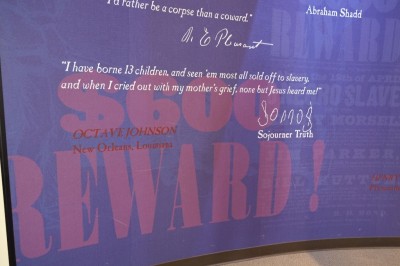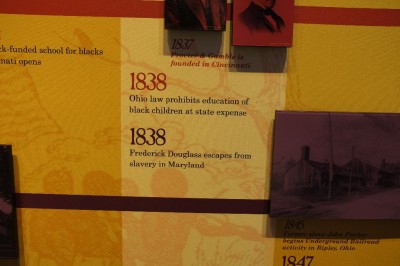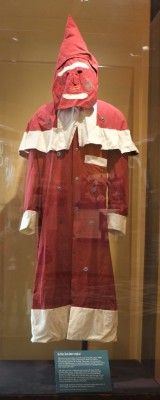Lessons from the Underground Railroad
Ray and I are grateful for a visit to the National Underground Railroad Freedom Center. While most of the museum was dedicated to the Underground Railroad, it also highlighted other issues of freedom, subjection, and slavery. The section on modern human trafficking was heart-wrenching.
The first museum artifact was outside. This is a section of the Berlin Wall which blocked so many East Germans trapped behind the “Iron Curtain” during decades of Communist domination in eastern Europe.

The words of slaves taught us powerful lessons as we walked through the museum. Here Sojourner Truth says: “I have borne 13 children, and seem ’em most all sold off to slavery, and when I cried out with my mother’s grief, none but Jesus heard me!”

On the timeline of the history of the Underground Railroad, we learned two things that happened one year after Proctor and Gable was founded in Cincinnati: Ohio law prohibited education of black children at state expense and Frederick Douglass escaped from slavery in Maryland.

In 1949 slave Ellen Craft disguised herself as a white man. Her husband William pretended to be her slave. The two boarded a train and escaped from slavery in Georgia. Harriet Tubman also escaped from slavery in Maryland that year. Afterwards, she began to help others escape–a total of 250!
The following year Congress passed the Fugitive Slave Law. It required police, courts, and private citizens throughout the northern states to help capture runaway slaves so they could be sent back to their masters. The dangers of running away increased dramatically when suddenly whites could be sent to jail, simply for not helping.

William and Ellen Craft were not the only slaves who escaped by pretending. Two white men and a black man helped 28 runaways by renting wagons and helping the runaways pretend to be part of a funeral procession.
The Civil War and constitutional amendments passed after the war brought an end to the need for an Underground Railroad. However, African Americans continued to face terrible hardships after gaining their freedom, as is evidenced by this Ku Klux Klan costume, which was the last display we saw.
Two of our young grandchildren were with us at the museum. When we saw this last display, one of them asked me, “Is that Santa Claus?” To her, Santa Claus is not the person who brings her presents at Christmas, but simply a character in a storybook like Jack and Jill or Winnie the Pooh. I praise God that she innocent about almost all of the about the dark side of human history.

When Fred Rogers of “Mr. Rogers Neighborhood” encountered tragedies as a child, his mother helped him by telling him to look for the heroes. The Underground Railroad had many heroes and heroines. Two were Levi and Catharine Coffin. They helped so many slaves escape that runaways called him the “president” of the Underground Railroads. By some accounts, they gave shelter to more than 2,000 runaway slaves. In 1847 they moved to Cincinnati where they opened a warehouse that handled goods produced by free labor and not slave labor. Mr. Coffin lectured and raised money in England and Europe to raise money to help former slaves. One year he raised more than $100,000.
On a large wall in the museum was this question:

Perhaps someday there will be a museum honoring homeschooling mothers, another group who is brave while the world around them is making different choices.
You are the light of the world.
Matthew 5:14

